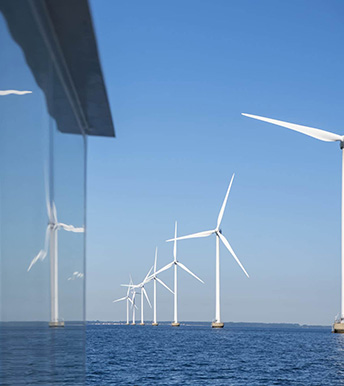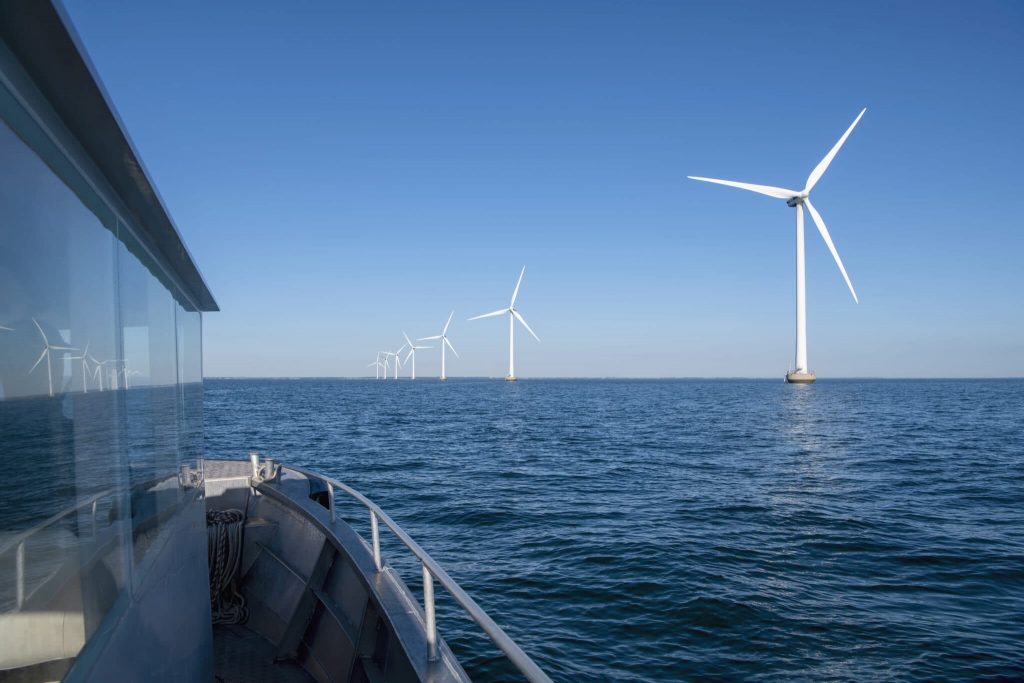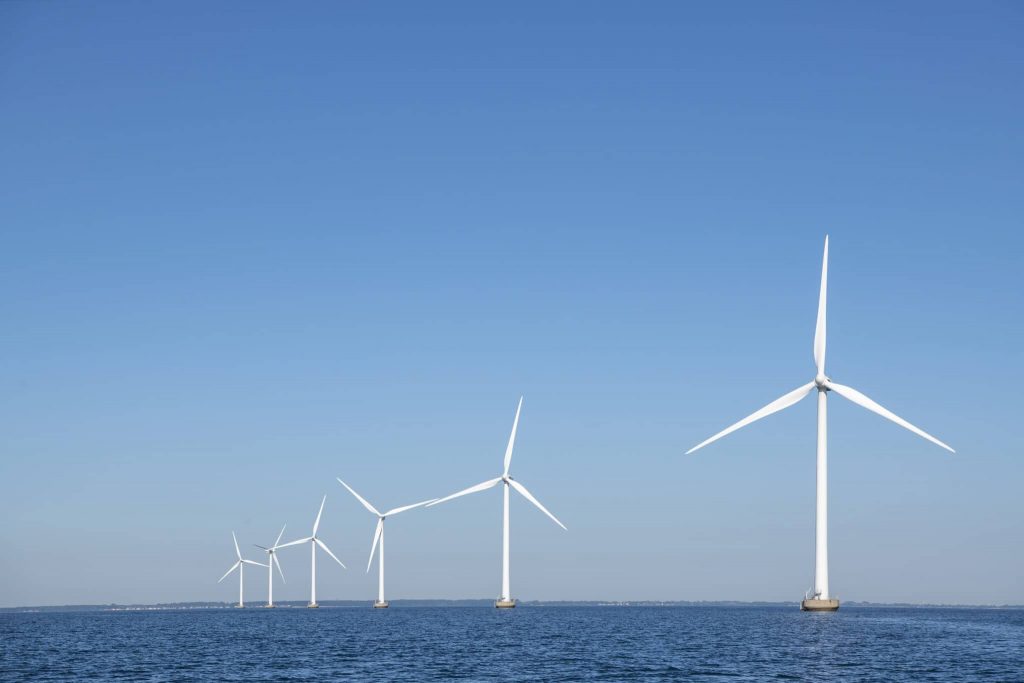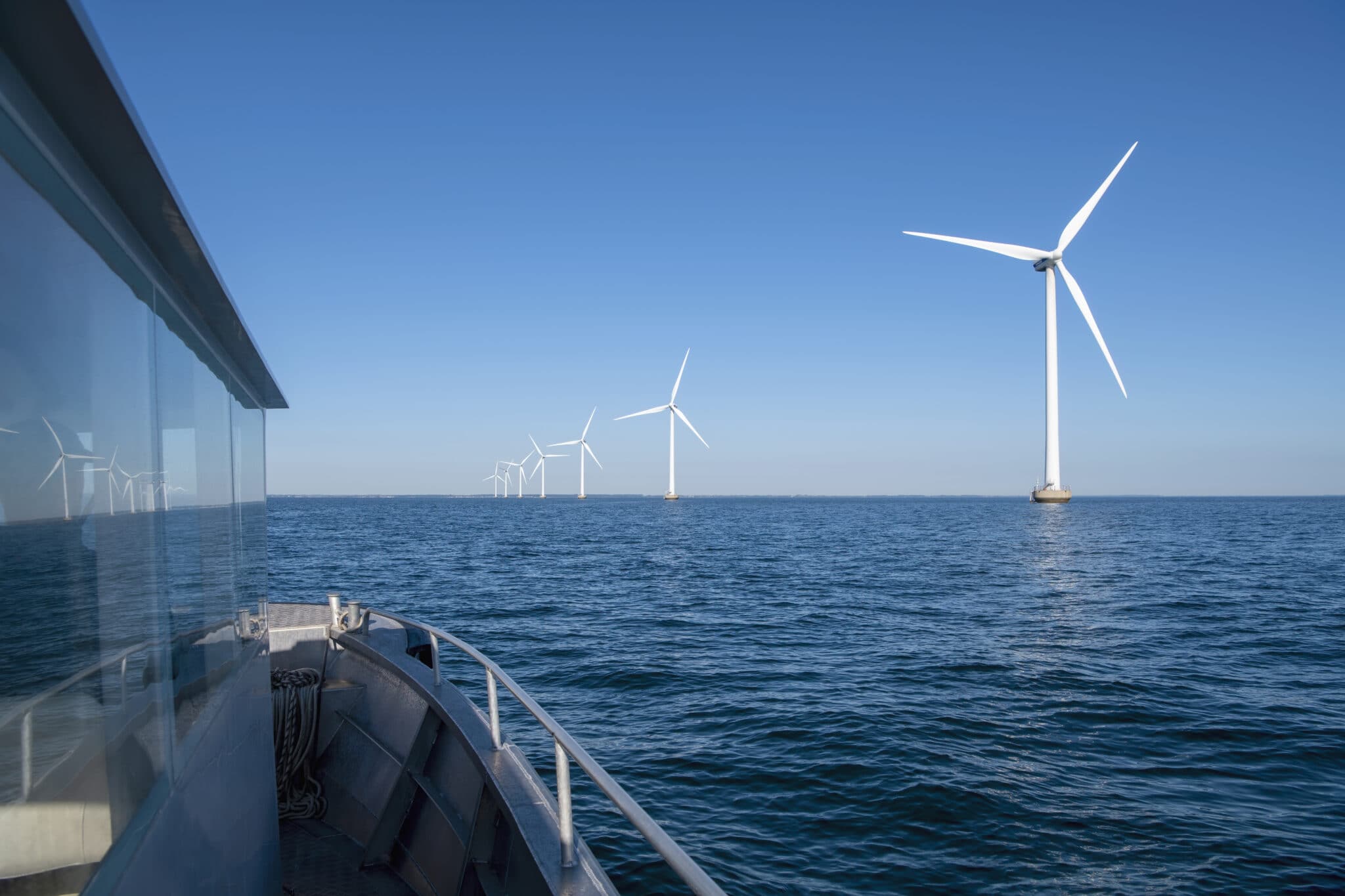A Copenhagen Energy company
Midwest Offshore Wind
We seek to develop an offshore wind farm that will provide green electricity for West Australian homes and businesses.
The Midwest Offshore Wind Farm, if approved by State and Federal authorities, will be located from 15km to 70km off the coast of Kalbarri, Western Australia.
The exact location of the turbines has not been defined and will be selected after stakeholder and community feedback.
An Introduction
Midwest Offshore Wind is a wholly owned subsidiary of Copenhagen Energy, a Danish renewable energy developer with significant cumulative experience in delivering offshore and onshore wind and solar photovoltaic (PV) developments in Denmark, Ireland, Italy, and the Philippines.
The size of the development area has been chosen to allow the flexibility to determine the final project area after taking local issues into account.
We are proposing to construct, operate, and ultimately decommission a world-class offshore wind farm in Commonwealth and State waters off the coast of Kalbarri, 500km north of Perth.
Initial feasibility studies have found that the offshore environment along the WA coastline offers a powerful and consistent wind resource, with the potential to generate more electricity at a steadier rate than most other renewable energy sources.
The consistent, strong wind patterns provide an opportunity to develop high-capacity offshore wind power near key demand centres.
We aim to increase our public presence in the Mid West region during the project’s early development phase. We will also continue a wide range of offshore and onshore studies to better understand the environmental, social, and economic impacts of our project. We are committed to understanding the concerns of the local community and the contribution they can make to our planning and development
The Commonwealth Minister for Climate Change and Energy is currently reviewing a number of areas within Commonwealth waters around Australia regarding their suitability for offshore renewable energy developments. When a new offshore renewable energy area is identified, the Commonwealth Department of Climate Change, Energy, the Environment and Water commences its new area assessment by conducting a public consultation process to gather feedback on the marine uses and users across the region. The Minister for Climate Change and Energy then considers all public submissions in determining whether the proposed area is suitable for offshore renewable energy developments.
The project’s timeline will be developed once there is clarity whether the project’s offshore area will be considered as suitable for offshore renewable energy by the Minister for Climate Change and Energy.
Regional Power
Kalbarri has abundant natural resources including wind and solar energy. The town’s electricity is currently supplied via transmission lines from Geraldton and augmented by a 1.6MW wind farm 25km from the town. The proposed Midwest Offshore Wind Farm will provide reliable renewable energy.
The Project
About the Project
The Midwest Offshore Wind Farm will have up to 200 turbines and six substations within Commonwealth waters.
Each turbine will deliver between 15MW and 25MW of electricity. Transmission cables on or under the seabed will transport the generated electricity onshore to a point north of Kalbarri, and from there to a load centre or electricity connection point.
The wind farm will have the capacity to generate in excess of 3GW of electricity (12-13TWh of power per year), enough to power three million homes.
Once commissioned, the wind farm will operate 24 hours a day, 365 days a year for up to 50 years.
The wind farm will support Australia’s commitment to reduce greenhouse gas emissions by 43 per cent by 2030, as well as the State Government’s target of enhanced climate resilience and net zero greenhouse gas emissions by 2050.
The Development Envelope currently covers an area 15km to 70km from the coast, running from approximately 30km north of Kalbarri to 50km south of Kalbarri. This area has been designed to avoid the boundary of the Abrolhos Islands and Midwest Trawl Fishery. This area will be further refined as the project progresses in response to environmental and social impacts identified during subsequent investigations and assessments, as well as from the stakeholder consultation process.
The Development Envelope will be reduced to an area no greater than 700km2 in line with the Offshore Electricity Infrastructure Act 2021 maximum area for a feasibility licence (and subsequent commercial licence).
Power in Kalbarri
Kalbarri has abundant natural resources including wind and solar energy. The town’s electricity is currently supplied via transmission lines from Geraldton and augmented by a 1.6MW wind farm 25km from the town. The transmission lines are subject to extended outages. The proposed Midwest Offshore Wind Farm and associated infrastructure will have the capacity to contribute to a stable power supply. We understand that community consultation conducted by Western Power as part of their renewable microgrid feasibility study indicated that the Kalbarri community is supportive of a renewable energy-based solution.
Offshore wind is a significant opportunity
$8bn
14,500
3 GW
8M
1: Study performed by Wind Denmark shows that 5,000 direct and 9,500 indirect jobs are created for every GW of offshore power
2: 610 g/kWh; AEMO -Source:www.aemo.com.au
Offshore wind
Offshore wind is expected to grow exponentially over the next decade and is one of the pillars towards a net-zero society.
Our research indicates that WA is facing a critical supply challenge where a major investment in network infrastructure is required for the South West Interconnecting System.
From 2020, renewables such as large-scale offshore windfarms to supplement both utility-scale and distributed energy needs have been discussed by organisations such as the Australian Energy Market Operator.
Leeuwin Offshore Wind is hoping to be part of the solution.
Why offshore?
Simply speaking, offshore wind projects can generate much more electricity with higher efficiency than typical onshore wind farms given the quality of Australia’s offshore wind resources. Over the past few decades, investment in offshore wind technology means it is now much less expensive to build offshore windfarms. The lower costs combined with better, more consistent resources and less potential to be impacted by onshore land use constraints makes it much more attractive to build a wind farm offshore.
When will it be ready?
A target to commence construction on the project will be identified once the Commonwealth Minister for Climate Change and Energy has announced the area as suitable for offshore renewable area development. This will developed based on feedback from stakeholder consultations, results of environmental surveys and assessments, and timings required to obtain all necessary government approvals.
Offshore wind is expected to grow exponentially over the next decade and is one of the pillars towards a net-zero society.
Our research indicates that Western Australia is at a critical supply challenge where a major investment in network infrastructure is required.
From 2020, renewables such as large-scale offshore wind farms to supplement both utility-scale and distributed energy needs have been discussed by organisations such as the Australian Energy Market Operator.
Midwest Offshore Wind is hoping to be part of the solution.
What will it involve?
Construction of the wind farm will take approximately three years. Pile driving is one of the options to install wind turbine generators, but we are looking at all construction options. Onshore construction is a relatively simple process. To connect to the onshore load centre or electricity grid, a transmission corridor will need to be cleared to enable trenching of the transmission lines. All vegetation will be restored once construction has been completed, and again at decommissioning.
Other Copenhagen Energy projects include:
CEO
Chairman
Development Manager, Australia
Investment Director
Finance Director
Sustainability and Approvals Manager
Project Manager
Project Engineer
Director of Trading
Stakeholder Engagement
Stakeholder Engagement
Media Manager
Meet the Team
Visionaries in
Renewable Energy
As it stands today, the Midwest Offshore Wind Farm will be the biggest in the world in terms of power generation. We bring considerable experience working across environmentally sensitive areas in global project and we have a vision to help WA fast track its path to decarbonising and easing reliance on fossil fuels.
Reports developed all over the world are stressing the need to quickly reduce emissions to stop the impacts of climate change. We want to be part of this journey in helping Australia hit net-zero targets.
Join the Team
Work with Copenhagen Energy.
We want your help.
Based on previous economic studies by Wind Denmark, we anticipate 14,500 jobs during construction. This includes 5,000 direct jobs and another 9,500 indirect jobs for every 1GW of power.
During operation we expect the project to employ 200 as well as more indirect employment.
Our mission as a company will only be fulfilled when we have zero emissions globally and when the climate crisis is combatted.
Working with us means working toward a sustainable future. We understand that the Western Australian workforce has significant experience in heavy industry. This brings us confidence that you will have transferrable skills that we can draw from and train up.
We seek to support local businesses through direct and indirect contracts to build on the economic prosperity for the regions.
Sustainability
Health and Safety
The wind turbine industry generally has an excellent safety record. All personnel that will be employed directly or indirectly will require thorough training to ensure they are proactive about creating and maintaining a ‘zero injuries or harm’ safety culture. We will invest in safety equipment and practices and keep up to date with the latest industry practices and track our safety performance.
Environment
Protecting the natural environment and mitigating environmental impacts is central to our proposal. We will conduct thorough environmental impact studies and apply the most stringent mitigation applications to preserve the local marine and onshore environment. Wind is a green technology, engaged across the globe to mitigate adverse environmental effects of carbon emissions. Australia is seeking to engage in renewable energy sources, and this project could assist Australia meet its environmental targets through responsible energy practices.
In addition to engaging leading environmental scientists to undertake rigorous peer-reviewed research to determine potential environmental impacts, we will also research opportunities for cost-effective innovation and development opportunities to minimise wildlife, marine and biological impacts.
Our stringent approach to environmental management will be required to meet statutory, regulatory and administrative requirements across both Australia’s State and Federal environmental agencies.

Quality Assurance
During engineering, construction and maintenance, Midwest Offshore Wind Farm will implement a stringent Quality Management System, aligned IS09001. This will assist to monitor and assure conformance of facility installation with all applicable design, engineering and installation standards and criteria. ISO9001 represents a systematic management approach for planning, implementing, verifying, and documenting construction to ensure the project satisfies technical, administrative and quality objectives.



Fishing, Tourism and Offshore Wind
Co-existing with local fishing activities
In other parts of the world, recreational and professional fishing activities and windfarms have co-existed.
As the turbines are 1-2 km apart, recreational fishers will be able to sail between the turbines, meaning we will not impede current boating activity once the turbines are fully operational.
For community and maritime safety, we will enact a small exclusion zone around each turbine and transfer station to avoid people trying to climb on the structures, which is extremely dangerous when not conducted in accordance with safety procedures.
There will also be small exclusion zones around individual turbines during construction in line with safety and maritime requirements.
We anticipate that over several years there will be marine growth on the turbine pylons which will attract various fish species and establish a new ecosystem similar to the Busselton Jetty.
We are committed to extensive consultation with recreational and professional fishing groups to gain feedback and insights as we determine the best locations for our turbines within the 15-70 km development area. It is our intention to do everything possible to ensure boating and fishing activities are not affected.
Approvals
Pioneering the offshore renewables approvals process
Midwest Offshore Wind seek to develop a project in harmony with local values, heritage and environment. The project will go through comprehensive Commonwealth and State environmental assessments before it can be approved and constructed. The primary aims of this process are to provide a detailed description of the project and to identify all potential environmental impacts. These assessments will also outline mitigation measures that will be taken to avoid or minimize these impacts. Throughout these processes we will encourage input from local communities to discuss their concerns and have a say on how the project is designed and implemented.
Offshore Electricity Infrastructure Licence
The project will also need to obtain a range of licences and approvals under the new Offshore Electricity Infrastructure Act 2021. The Australian Government is developing the regulatory framework to support the legislation. As the Government defines this process we will ensure that local communities and interested parties are kept informed.
Referral Submissions
Where are we at?
The Midwest Offshore Wind project was referred to the Australian Government (Department of Climate Change, Energy, the Environment and Water) in May 2022 under the Environment Protection and Biodiversity Conservation Act 1999. This is a key piece of environmental legislation that provides protection of the environment, especially matters of national environmental significance. The Minister for the Environment assessed the project as a “controlled action” requiring assessment by a Public Environment Report. The project will also be referred to the WA Environmental Protection Authority for assessment under the Environmental Protection Act 1986 in due course.
Following these referral assessments by the Commonwealth and State Governments, the project will begin an extensive range of technical studies. These studies will be conducted by specialists within each field and designed to identify all potential environmental and social impacts for which commensurate management measures will be assigned. We welcome community input to these studies so that local concerns, interests and suggestions are considered.
